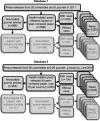Disclosure of study funding and author conflicts of interest in press releases and the news: a retrospective content analysis with two cohorts
- PMID: 33419908
- PMCID: PMC7798706
- DOI: 10.1136/bmjopen-2020-041385
Disclosure of study funding and author conflicts of interest in press releases and the news: a retrospective content analysis with two cohorts
Abstract
Objectives: To examine how often study funding and author conflicts of interest are stated in science and health press releases and in corresponding news; and whether disclosure in press releases is associated with disclosure in news. Second, to specifically examine disclosure rates in industry-funded studies.
Design: Retrospective content analysis with two cohorts.
Setting: Press releases about health, psychology or neuroscience research from research universities and journals from 2011 (n=996) and 2015 (n=254) and their associated news stories (n=1250 and 578).
Primary outcome measure: Mention of study funding and author conflicts of interest.
Results: In our 2011 cohort, funding was reported in 94% (934/996) of journal articles, 29% (284/996) of press releases and 9% (112/1250) of news. The corresponding figures for 2015 were: 84% (214/254), 52% (131/254) and 10% (58/578). A similar pattern was seen for the industry funding subset. If the press release reported study funding, news was more likely to: 22% if in the press release versus 7% if not in the press release (2011), relative risk (RR) 3.1 (95% CI 2.1 to 4.3); for 2015, corresponding figures were 16% versus 2%, RR 6.8 (95% CI 2.2 to 17). In journal articles, 27% and 22% reported a conflict of interest, while less than 2% of press releases or news ever mentioned these.
Conclusions: Press releases and associated news did not frequently state funding sources or conflicts of interest. Funding information in press releases was associated with such information in news. Given converging evidence that news draws on press release content, including statements of funding and conflicts of interest in press releases may lead to increased reporting in news.
Keywords: medical journalism; public health; statistics & research methods.
© Author(s) (or their employer(s)) 2021. Re-use permitted under CC BY. Published by BMJ.
Conflict of interest statement
Competing interests: None declared.
Figures


Similar articles
-
[Exaggerated health news: association between exaggeration in university press releases and exaggeration in news media coverage].Ned Tijdschr Geneeskd. 2018 Jan 2;162(1):D1936. Ned Tijdschr Geneeskd. 2018. PMID: 30295017 Dutch.
-
Influence of medical journal press releases on the quality of associated newspaper coverage: retrospective cohort study.BMJ. 2012 Jan 27;344:d8164. doi: 10.1136/bmj.d8164. BMJ. 2012. PMID: 22286507 Free PMC article.
-
The association between quality measures of medical university press releases and their corresponding news stories-Important information missing.PLoS One. 2019 Jun 12;14(6):e0217295. doi: 10.1371/journal.pone.0217295. eCollection 2019. PLoS One. 2019. PMID: 31188838 Free PMC article.
-
Reporting of conflicts of interest in meta-analyses of trials of pharmacological treatments.JAMA. 2011 Mar 9;305(10):1008-17. doi: 10.1001/jama.2011.257. JAMA. 2011. PMID: 21386079 Review.
-
Impact of Reporting Bias, Conflict of Interest, and Funding Sources on Quality of Orthopaedic Research.J Arthroplasty. 2024 May;39(5):1348-1352. doi: 10.1016/j.arth.2023.11.017. Epub 2023 Nov 14. J Arthroplasty. 2024. PMID: 37972663 Review.
References
Publication types
MeSH terms
Grants and funding
LinkOut - more resources
Full Text Sources
Other Literature Sources
